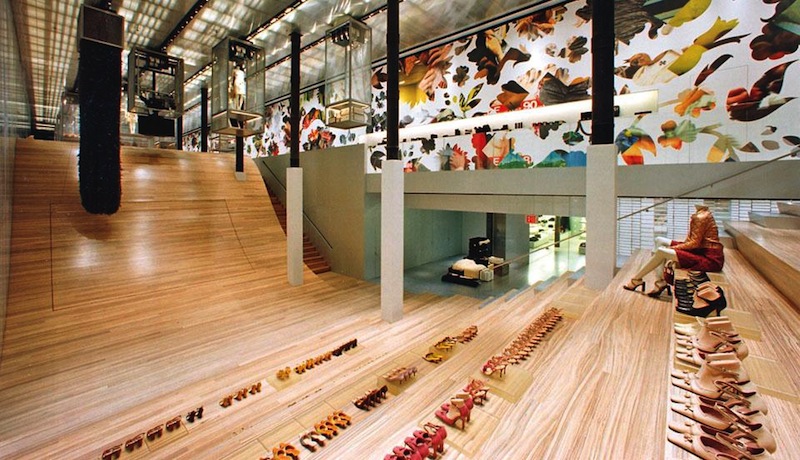Prada: "Epicenter", New York/ Tokyo
Informationsarchitektur und Instore Technologie für die Flagship Stores
Architektur:
– USA (New York, Los Angeles, San Francisco): OMA/AMO
– Japan (Tokyo): Herzog & Demeuron (Eröffnung 2003)
Instore Technologie:
– OMA/AMO: Shopping Concept
– IDEO Human Factors: Interaction Design
– Kramdesign: Computational Design
Youtube-Video: http://www.youtube.com/watch?v=3pXNYciHCLc&
Credits:
– Texte IDEO web feature on the Prada project
– Bilder: siehe einzelne Bildbeschreibungen
In December 2001 the Italian haute couturier Prada opened its groundbreaking new «epicenter» store in New York City, designed by the Dutch architect Rem Koolhaas. IDEO, working with Koolhaas and his architecture and research firm OMA/AMO, created the invisible technology […], incorporated into the design of the store’s information architecture, as well as the interactive dressing rooms and the in-store devices […].
The enabling technology for the store is radio-frequency ID tagging (RFID). All merchandise has its own RFID tag. When scanned and detected, immediate access is provided to a database where there is rich stream of content for every garment, shoe, and bag. This is in the form of sketches, catwalk video clips, and color swatches.
An RFID tag is also part of a PRADA customer card. Customer preferences are stored on the database, and only the customer card provides access. This information is used to customize the sales experience and further enhance the service provided to the card-holding customer.
The wireless staff device provides information to the sales associate. It is used to scan merchandise for inventory information, and when used in conjunction with a ubiquitous display it functions as a remote control, allowing the sales associate to highlight sketches and catwalk video clips directly in front of the customer.
The Staff Device […] is partly made of translucent polyurethane so that the staff members need not treat it too delicately. The device scans staff tags and customer cards, allows inventory checks, reserves dressing rooms, acts as a remote control to access information on the store’s ubiquitous screens, has a laser pointer, and allows stock to be ordered and delivered.
The interactive dressing rooms […] are presented as simple eight-foot-square glass booths. One wall has two interactive closets, one for hanging clothes and one with shelves. Sensors in the closets detect the electronic tags on store items and trigger a touch screen that displays the item and its related information, from availability to permutations of color, fabric, and size.
As garments are hung in the closet their tags are automatically scanned and detected via RF antennae embedded in the closet. Once registered, the information is automatically displayed on an interactive touch screen, enabling the customer to select alternative sizes, colors, fabrics, and styles, or see the garment worn on the PRADA catwalk as slow-motion video clips.
The dressing rooms also contain a video-based «Magic Mirror» which allows a customer to see an image of their back. As the customer begins to turn in front of the mirror the image becomes delayed, allowing the customer to view themselves in slow motion from all angles.
